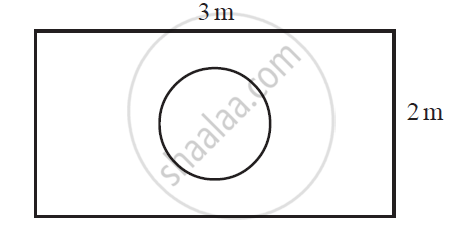Advertisements
Advertisements
प्रश्न
In a simultaneous throw of a pair of dice, find the probability of getting a number other than 5 on any dice.
उत्तर
In a throw of pair of dice, total no of possible outcomes = 36 (6 × 6) which are
(1, 1) (1, 2) (1, 3) (1, 4) (1, 5) (1, 6)
(2, 1) (2, 2) (2, 3) (2, 4) (2, 5) (2, 6)
(3, 1) (3, 2) (3, 3) (3, 4) (3, 5) (3, 6)
(4, 1) (4, 2) (4, 3) (4, 4) (4, 5) (4, 6)
(5, 1) (5, 2) (5, 3) (5, 4) (5, 5) (5, 6)
(6, 1) (6, 2) (6, 3) (6, 4) (6, 5) (6, 6)
E ⟶ event of getting a no other than 5 on any dice
No. of favourable outcomes = 25 {(1, 1) (1, 2) (1, 3) (1, 4) (1, 6) (2, 1), (2, 2) (2, 3)
(2, 4) (2, 6) (3, 1) (3, 2) (3, 3) (3, 4) (3, 6) (4, 1) (4, 2) (4, 3) (4, 4) (4, 6) (6, 1) (6, 2)
(6, 3) (6, 4) (6, 6)}
Total no. of possible outcomes = 36
We know that, Probability P(E) =`"No.of favorable outcomesv"/"Total no.of possible outcomes"`
P(E) =25/36
APPEARS IN
संबंधित प्रश्न
Suppose you drop a die at random on the rectangular region shown in the given figure. What is the probability that it will land inside the circle with diameter 1m?

A die is thrown. Find the probability of getting 2 or 4
A bag contains 3 red balls and 5 black balls. A ball is drawn at random from the bag. What is the probability that the ball drawn is Black
Two customers are visiting a particular shop in the same week (Monday to Saturday). Each is equally likely to visit the shop on any one day as on another. What is the probability that both will visit the shop on consecutive days?
A bag contains 8 red, 6 white and 4 black balls. A ball is drawn at random from the bag. Find the probability that the drawn ball is Not black
Two dice (each bearing numbers 1 to 6) are rolled together. Find the probability that the sum of the numbers on the upper-most faces of two dice is 7, 8 or 9.
A two digit number is to be formed from the digits 0, 1, 2, 3, 4. Repetition of the digits is allowed. Find the probability that the number so formed is a - multiple of 4.
A die is rolled twice. Find the probability that 5 will come up exactly one time.
1000 families with 2 children were selected randomly , and the following data were recorded :
| Number of girls in a family | 0 | 1 | 2 |
| Number of families | 333 | 392 | 275 |
Find the probability of a family , having
(iii) no girl
A bag contains 3 red and 2 blue marbles. A marble is drawn at random. ‘The probability of drawing a black marble is ______.
